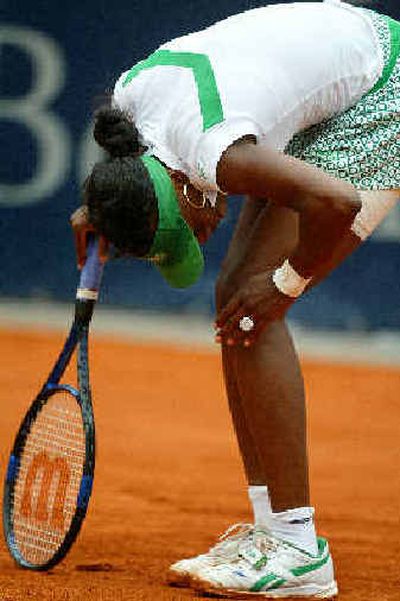Injury bug hitting hard

Not long ago, there were complaints that Venus and Serena Williams were too dominant, hurting tennis’ popularity by meeting in one Grand Slam final after another.
Oh, how the sport could use some of that continuity now.
The sisters haven’t played each other since Wimbledon, more than 10 months ago. The All England Club also was the site of the last matches featuring a Williams against Justine Henin-Hardenne or Kim Clijsters. The Belgians, who supplanted the siblings at Nos. 1-2, have squared off just once in 2004.
And it’s not simply that the best in women’s tennis aren’t playing each other — they’re hardly playing anyone, it seems.
Nine of the top 10 players in the WTA Tour rankings missed time at some point this season. Clijsters, twice a French Open runner-up, already ruled herself out with a hurt left wrist. The clay-court major starts May 24.
“I’m definitely concerned about it,” WTA Tour CEO Larry Scott said. “In talking to people who have been around women’s tennis for a long time, they said it’s bizarre to see so many flukish injuries and illnesses among top players so early in a season.”
The tour says its research shows injuries haven’t increased overall. But:
— Henin-Hardenne hasn’t competed in five weeks because of what the tour called a virus;
— Serena Williams just returned from nearly a month off with a sore left knee, the same one that was operated on Aug. 1, keeping her away from the tour until March;
— Venus Williams couldn’t play in last weekend’s German Open final after twisting her left ankle in the semifinals, and she lost the last half of 2003 to an abdominal strain.
“We have very demanding schedules,” she said in Berlin. “We play nonstop. When we don’t, it’s an issue.”
The list of sidelined stars goes on: Jennifer Capriati’s hip, Amelie Mauresmo’s back and Lindsay Davenport’s arm prevented them from playing in tournaments this season. Monica Seles hasn’t competed in a year; Martina Hingis retired at 22 in 2002 after operations on both ankles.
“At the moment, it’s like there is a spell following the tour,” Clijsters said in Berlin.
The main reasons cited for the host of hospital visits: too many matches, too few breaks, too much emphasis on power.
“I’ve been talking about this for a long time, and it’s not going to change until the structure of the tour changes,” Martina Navratilova said at this week’s Italian Open. “People play too much. The ranking system, the computer system, is encouraging people to play more, and then it’s encouraging them to play more when they’re not well, because they don’t want to miss out on anything.”
It’s a particular worry in an individual sport that counts on personalities and rivalries — and has dipping TV ratings.
Still, citing three new deals worth a total of $15 million over five years, Scott said, “We haven’t been more successful from a marketing perspective than we have in the past three months.”
He said he’s committed to addressing the injury issue, discussing possible solutions at recent meetings with European and U.S. tournament directors and players’ representatives.
“Nothing is more important than having our players healthy and able to play their best tennis,” he said. “It’s at the top of my priority list.”
Among the proposals:
• Starting seasons later by pushing back the Australian Open a week or two (unlikely before 2007);
• Ending seasons earlier by moving up the Fed Cup final;
• Changing the ranking system to strike a balance between quality and quantity.
The men’s tour has been involved in such talks, although ATP CEO Mark Miles noted few male stars were hurt lately.
This week’s Hamburg Masters, for example, had 16 of the top 19 men. Andre Agassi plays a limited clay-court schedule, while reigning French Open champion Juan Carlos Ferrero (wrist) and U.S. Open champion Andy Roddick (knee) cited injuries; all are expected at Roland Garros.
Still, 2000 U.S. Open champion Marat Safin and 2002 Wimbledon finalist David Nalbandian have voiced concerns about lightening players’ loads.
“A somewhat longer offseason is a good idea, primarily because it brings the guys back fresher,” Miles said.
But while elite players might want extra rest, Miles said lower-ranked players aren’t “looking for more time off. They’re not concerned about a longer offseason. They’re concerned about opportunity” to play.